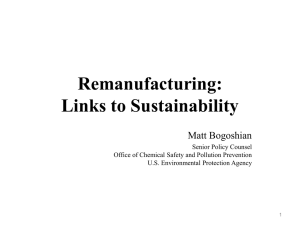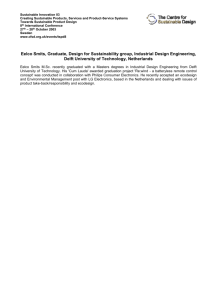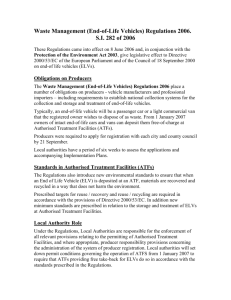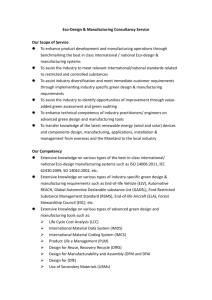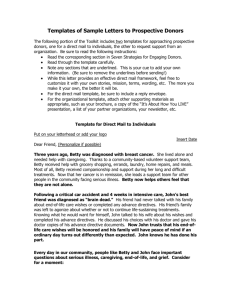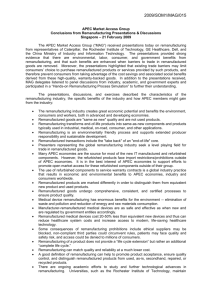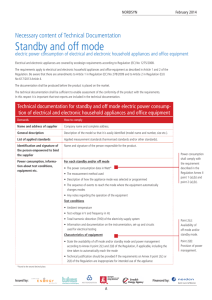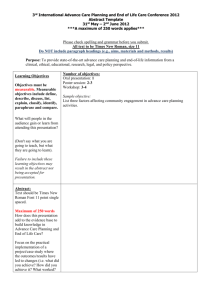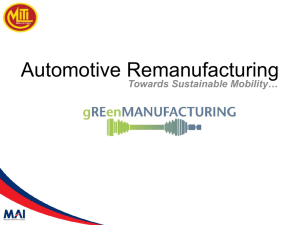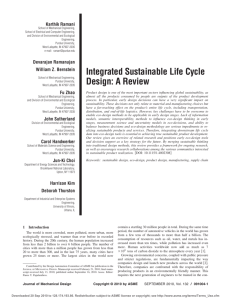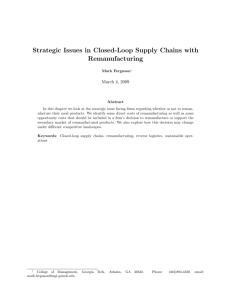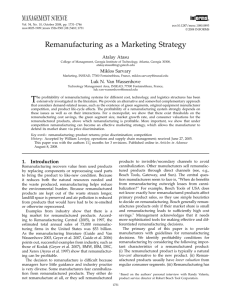3.3 Environmental Design Support Tool (EDST)
advertisement
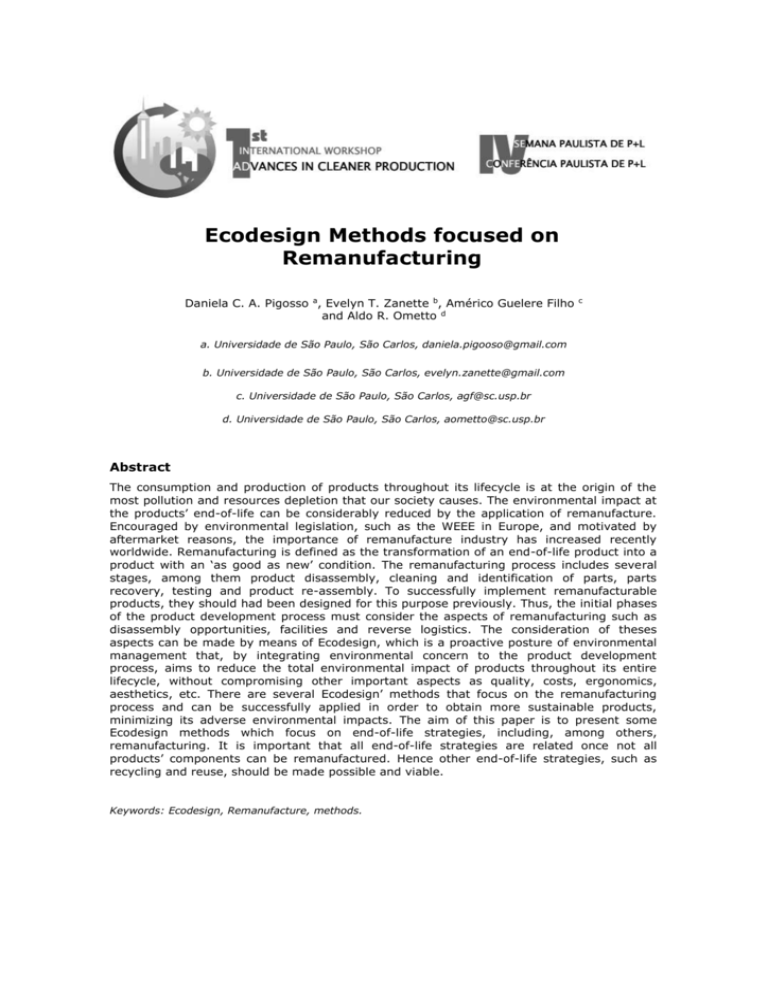
Ecodesign Methods focused on Remanufacturing Daniela C. A. Pigosso a, Evelyn T. Zanette b, Américo Guelere Filho and Aldo R. Ometto d c a. Universidade de São Paulo, São Carlos, daniela.pigooso@gmail.com b. Universidade de São Paulo, São Carlos, evelyn.zanette@gmail.com c. Universidade de São Paulo, São Carlos, agf@sc.usp.br d. Universidade de São Paulo, São Carlos, aometto@sc.usp.br Abstract The consumption and production of products throughout its lifecycle is at the origin of the most pollution and resources depletion that our society causes. The environmental impact at the products’ end-of-life can be considerably reduced by the application of remanufacture. Encouraged by environmental legislation, such as the WEEE in Europe, and motivated by aftermarket reasons, the importance of remanufacture industry has increased recently worldwide. Remanufacturing is defined as the transformation of an end-of-life product into a product with an ‘as good as new’ condition. The remanufacturing process includes several stages, among them product disassembly, cleaning and identification of parts, parts recovery, testing and product re-assembly. To successfully implement remanufacturable products, they should had been designed for this purpose previously. Thus, the initial phases of the product development process must consider the aspects of remanufacturing such as disassembly opportunities, facilities and reverse logistics. The consideration of theses aspects can be made by means of Ecodesign, which is a proactive posture of environmental management that, by integrating environmental concern to the product development process, aims to reduce the total environmental impact of products throughout its entire lifecycle, without compromising other important aspects as quality, costs, ergonomics, aesthetics, etc. There are several Ecodesign’ methods that focus on the remanufacturing process and can be successfully applied in order to obtain more sustainable products, minimizing its adverse environmental impacts. The aim of this paper is to present some Ecodesign methods which focus on end-of-life strategies, including, among others, remanufacturing. It is important that all end-of-life strategies are related once not all products’ components can be remanufactured. Hence other end-of-life strategies, such as recycling and reuse, should be made possible and viable. Keywords: Ecodesign, Remanufacture, methods. 2 1st International Workshop | Advances in Cleaner Production 1 Introduction Sustainability is a systemic concept related to the continuity of economic, social, institutional and environmental aspects. The consumption and production of products throughout their lifecycles is at the origin of the most pollution and resources depletion that our society causes. To successfully implement sustainable business models, it is necessary to promote a transaction from the economic values we still carry to the life cycle thinking, due to raw materials shortness, environment’s limitation to absorb residues and emissions, and the consumption needs of a growing population. All products cause some sort of impact during their life cycle, from raw material extraction through manufacturing, use and final disposal. These environmental effects are a result of linked decisions, made throughout the products life cycle (Baumann; Boons; Bragd, 2002). Life cycle economic systems result from the integration of actions which are economically viable and environmentally efficient and may focus on different end-of-life treatment alternatives and lifetime extension strategies. The grounding of a strategy for integrating environmental issues into the product development process must consider the products complexity and diversity and the fast evolution of knowledge on products and services design (Comissão das Comunidades Européias, 2001). It is important to notice, however, that no environmental improvement will be achieved unless new products are competitive and can fully replace low environmental performance products. Thus, product’s functionality, performance, aesthetics, quality and cost must be compatible with environmental requirements (Nielsen; Wenzel, 2001). Ecodesign may be defined as a strategic design activity settled to conceive and develop sustainable solutions. It generates sets of products, services and knowledge that enable consumers to achieve sustainable results in sustainable ways. From another point of view, Ecodesign is a proactive management approach which directs product development towards environmental impacts reduction throughout its life cycle, without compromising other criteria such as performance, functionality, aesthetics, quality and cost (Johansson, 2002; Weenrn, 1995). The practice of Ecodesign is essential to companies that recognized that environmental responsibility is vital to long term success since it promotes advantages such as reputation improvement, cost reduction, decrease in risks, lessening in residue generation, product innovation and draws new consumers (Bakshi; Fiksel, 2003). Different Ecodesign methods have been developed to evaluate environmental impacts, putting in evidence potential problems and conflicts and facilitating the choice among possible product aspects by comparison of environmental design strategies. In this paper are considered Ecodesign methods any systematic means to deal with environmental issues during product development process (Baumann; Boons; Bragd, 2002; Byggeth; Hochschorner, 2006). Remanufacturing is an end-of-life strategy that reduces the use of raw materials and energy necessary to manufacture new products. Economically, remanufacture is an interesting strategy due to preserving the product’s value added during the design and manufacturing processes. As for the environment, the importance of remanufacture lies on extending the product’s lifetime, by diverting them into a second life, given that if the products last longer through remanufacturing, less material can be used to meet customer needs (Zwolinsky; Lopez-Ontiveros; 3 1st International Workshop | Advances in Cleaner Production Brissaud, 2006). The remanufacture process can be defined as a product recovery strategy focused product restoration and reconditioning of its parts, in order to rebuild it according to its original design. Remanufacture is an effective manner to maintain products in a closed-loop and to guarantee products end-of-life proper management. Remanufacturing helps reducing environmental and economical costs of manufacturing and final disposal costs of products and components (White; Massanet; Rosen; Beckman, 2003; Kerr; Ryan, 2001). Remanufacturing as an industrial process includes several stages, among them product disassembly, cleaning and identification of parts, parts recovery, testing and product re-assembly. To successfully implement remanufacturable products, they should have been designed for this purpose previously. Some of the desirable characteristics for remanufacturable products are easy disassembling, easy cleaning, wear resistant, easy to reassemble and valuable when remanufactured (Kerr; Ryan, 2001; White; Massanet; Rosen; Beckman, 2003; Sundin; Bras, 2005). 2 Methodology The main methodology applied was a systematic review. The systematic review allows the researcher to map all existing knowledge and initiatives and also those which were previously developed. Besides preview discoveries, techniques, ideas and exploratory manners for the topic, the systematic review allows the evaluation of information relevance related to the issue proposed, its synthesis and summarization. Through the systematic review it was possible to identify several Ecodesign methods, some of them focused on end-of-life strategies and alternatives. In this paper, six of these methods will be presented due to their representativity and applicability according to literature. 3 Results and Discussion There are several Ecodesign’ methods that focus on end-of-life alternatives, such as remanufacturing, and can be successfully applied in order to obtain more sustainable products. Six examples of Ecodesign methods oriented to the end-oflife of products are listed below: 3.1 Environmental Design Industrial Template (EDIT) This software acknowledges that economics and product design are the factors establishing the end-of-life of products. The software allows the user to analyze the effects of product’s design at its end-of-life. The concept of the method is the generation of a product disassembly sequence that optimizes profit generation in a way that end-of-life treatments can be evaluated. This method allows the designer to define how and with which material the product will be made, choose parts and processes considering some environmental and economic information, access and modify the available data base, and simulate end-of-life results. The user must supply information on materials (weight, toxicity, disposal costs, and information on recycling – material recycling cost and energy used in the process). If parts can be reused or remanufactured, user must inform its costs as well as retail prices. Thus, given the products design, EDIT is able to simulate an optimum disassembly sequence with larger economic value. As a result, the designer knows to which 4 1st International Workshop | Advances in Cleaner Production extend the product can be reused, remanufactured, recycled or disposed, plus time and energy spent on the disassembly process (Spicer; Wang, 1997). 3.2 D4N This is a design method that not only analyzes products life cycle by including all end-of-life issues in the analysis and evaluates designs ecological and economically, but also provides guidelines to redesign. Some of these guidelines are incorporates to the method in a way to make redesign process semi-automatic. Existing data from CAD systems are automatically extracted and located in a connection graphic, permitting the generation of a disassembly sequence so that important components are removed quickly, avoiding unnecessary disassemblies. User’s data is complemented by data bases holding information on materials, environmental impacts, end-of-life treatments and costs. Data bases must contain, to each material, its disposal method, its environmental impact according to an ecoindicator value (PRé Consultants) and the costs of recycling or reprocessing the material. Designer’s data are necessary to establish the connections among parts and parts materials. The design is evaluated and the program gives the user guidelines to redesign. (Murtagh; Bamba; Iwama) 3.3 Environmental Design Support Tool (EDST) EDST evaluates products design on terms of its environmental sustainability, i.e. material selection, recyclability and disassembly analysis. According to the writers, disassembly is the first step in evaluating a product’s environmental performance by this tool, and it provides the time needed on disassembly, number of distinct components and other information. The tool generates an index number to help evaluating the disassembly process (larger numbers imply more difficult disassembly). Material evaluation is made through and index composed by weight of material, total amount of different material used and total amount of dangerous and recyclable materials used. This index is obtained through a questionnaire and its guidelines. Recyclability evaluation is focused on residue management and pollution control. Material end-of-life alternatives are reuse, remanufacture, recycling, incineration and final disposal, according to the kind of material used (Yu; Zhang; Ertas, 1999). 3.4 Green Design Advisor This method evaluates products through eight metrics: number of materials, mass, amount of recycled material, toxicity, energy use, disassembly time and end-of-life disassembly cost. The evaluation is made in two steps: definition of an appropriate data model that includes all relevant data in determining products environmental impact, and environmental point’s calculus. Thus, the method can identify the weaknesses of the product and indicates the direction for improvement (Sun; Han; Ekwaro-Osire; Zhang, 2003). 3.5 Method to Assess the Adaptability of Products (MAAP) The main purpose of this method is to evaluate the product’s conformity at assembly, maintenance, repair, upgrade and remanufacture processes, as locating potential design improvement areas. Conformity is represented by metrics (adaptation). The closer the value is to one, better the design adaptation, and the closer to zero, the worst it is. Methods clearness is guaranteed by sub-metrics (remanufacturing, maintenance, repair and upgrading), which establish together 5 1st International Workshop | Advances in Cleaner Production the adaptation metric, as well as parts, connectors and space. The sub-metrics are divided in sub-criteria: parts (components and removal direction), connectors (number of different components in each group, number of different components, number of connectors and tools), space (visibility, reach, identification and direction to disassembly), remanufacture (disassembly maintenance, assembly and architecture structure), repair (disassembly, assembly and architecture structure repair) and upgrade (functional and interface decoupling). The evaluation is made through the ratio between the ideal and the real values of a specific parameter. Based on the metrics result, the method provides guidelines to product improvement in terms of its adaptation (Williems; Selinger; Duflou; Basdere, 2003). 3.6 Product Life Cycle Planning (LCP) This method considers detailed environmental requirement through life cycle perspective, and the environmental aspect is integrated to quality and cost aspects at initial design phases. The study focus on the following life cycle options: “product upgrade”, “product maintenance”, “lifetime extension”, “product or component reuse”, and “material recycling”. At the first stage, a medium or long term production plan and a product plan are established according to business requirements and products lifetime. At the next stage, product specifications and its life cycle are established. The conciliation between costumer and environmental requirements (in accordance with the company’s strategy) lead to an adjustment of values for quality and environmental characteristics. LCP is supported by a method software, the LCPlanner, based on an Microsoft Excel macro. LCPlanner automatically produces several matrix and analysis graphics using entry data supplied by the designer and data from LCA and QFD databases (Kobayashi, 2005). 4 Conclusions The remanufacturing process is an end-of-life alternative that aims at extending the life of products by redirecting them to a second life. It may become more feasible on the same measure as Ecodesign methods are made available to designers. There are several methods of Ecodesign that can be applied into the earlier phases of the product development process in order to improve the feasibility of the remanufacturing process. It can be observed that these methods usually include more than one end-of-life strategy, since all end-of-life strategies are related and not all products’ components can be remanufactured. Hence other end-of-life strategies, such as recycling and reuse, should be made possible and viable. In Brazil, there are many variables to be considered in order to implement a remanufacturing system, such as governmental regulation of these activities by means of laws and directives, establishment of a reverse logistics system and proper product final destination by users so it may return to remanufactures. 5 References Bakshi, B. R.; Fiksel, J., 2003. The Quest for Sustainability: challenges for process systems engineering. In: AIChe Journal Vol. 49, No. 6, p. 1350 – 1358. Baumann, H.; Boons, F.; Bragd, A., 2002. Mapping the green product development field: engineering, policy and business perspectives. In: Journal of Cleaner Production 10 409 – 425. 6 1st International Workshop | Advances in Cleaner Production Byggeth, S.; Hochschorner, E., 2006. Handling trade-offs in Ecodesign tools for sustainable product development and procurement. In: Journal of Cleaner Production 14 1420-1430 Comissão Das Comunidades Européias, 2001. Livro verde sobre la política integrada relativa aos produtos. Bruxelas. Johansson, G. Success factor for integration of Ecodesign in product development: A review of state of the art. In: Environmental Management and Health, Vol 13, Nº 1, pp 98-107. Kerr, W.; Ryan, C., 2003. Eco-efficiency gains from remanufacturing: A case study of photocopier remanufacturing at Fuji Xerox Australia. Journal of Cleaner Production 9, 75–81. Kobayashi, H., 2005. Strategic evolution of eco-products: a product life cycle planning methodology. In Design. Nielsen, P.H.; Wenzel, H., 2002. Integration of environmental aspects in product development: a stepwise procedure based on quantitative life cycle assessment. In: Journal of Cleaner Production 10 247-257. Spicer, A.; Wang, M., 1997. Environmental Design Industrial Template (EDIT) a software tool for analysis of product retirement. In Journal of Cleaner Production. Sun, J.; Han, B.; Ekwaro-Osire, S.; Zhang, H-C., 2003. Design for Environment: Methodologies, Tools and Implementation. In: Journal of Integrated Design and Process Science. Sundin, E.; Bras, B., 2005. Making functional sales environmentally and economically beneficial through product remanufacturing. In: Journal of Cleaner Production 13 913-925. Weenrn, J. C., 1995. Towards sustainable product development. In: Journal of Cleaner Production, Vol. 3, No. 1-2, 95-100. White, C.D.; Masanet, E.; Rosen, C.M.; Beckman, S.L., 2003. Product recovery with some byte: an overview of management challenges and environmental consequences in reverse manufacturing for the computer industry. Journal of Cleaner Production 11, 445-458. Willems, B.; Seliger, G.; Duflou, J.; Basdere, B., 2003. Contribution to Design for Adaptation: Method to Assess the Adaptability of Products (MAAP) In: Proceedings of EmDesIgnW: Third International Symposium on Environmentally Conscious Design and Inverse. Yu, S. Y.; Zhang, H-C.; Ertas, A., 1999. Environmental Conscious Design an Introduction to EDST. In Journal of Integrated Design and Process Science. Zwolinski, P.; Lopez-Ontiveros, M.A.; Brissaud, D., 2006. Integrated design of remanufacturable products based on product profiles. Journal of Cleaner Production vol. 14 1333-1345.
